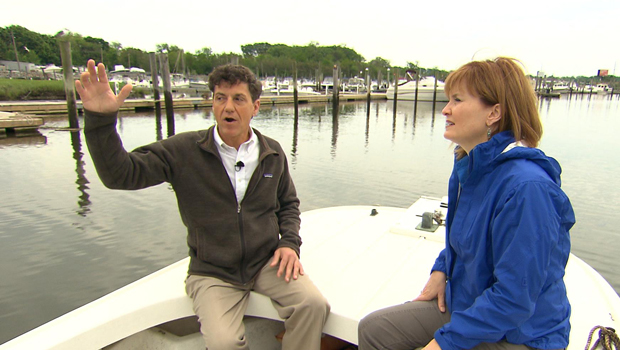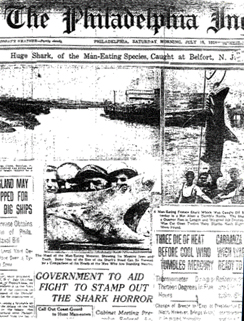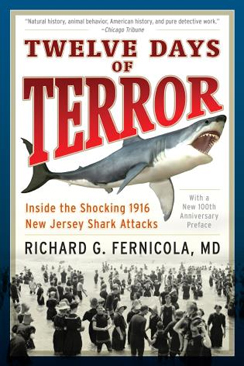Remembering the Titanic of shark attacks
The scariest word at any beach vacation has to be the shouted warning: SHARK! And we've been hearing it for a century now. Our Cover Story is reported by Anna Werner:
Welcome to Beach Haven, a slice of heaven on the New Jersey shore.
"It's wonderful and we can't wait for another great summer here," one visitor said.
"I've been coming here since I was 18 months old," one man said. "Love this place. Love the beach."
"It's so relaxing -- just a beautiful beach," said another woman
The perfect place to take a dip and put your mind at ease ... unless, of course, you have a certain movie theme playing in your head...
Excerpt from "Main Title" of "Jaws" by John Williams
It was 41-years ago that "Jaws" left America trembling in fear. You know the story: a rogue shark terrorizing a tourist town.
While the book and blockbuster film are fiction, 100 years ago in New Jersey there was the real thing, with eerie similarities to "Jaws" -- a series of deadly shark attacks.
And it began right here in Beach Haven.
Author and physician Richard Fernicola has written about the 1916 events: "America thought they were having one last golden gentle, innocent summer. But that wasn't to be.
"The extraordinary nature of the attacks, the viciousness -- in that period -- still stands out. It stood out then, and it stands out even more, perhaps, in retrospect."
- Thousands of sharks swarming off Florida shore (02/17/16)
- Shark safety tips: How to stay safe in the water
- Photographer gets up close and personal with great white sharks (04/20/16)
- Gallery: Shark attacks
Back then, sharks were a distant offshore curiosity. It was widely assumed they would never pose a threat to man. That all changed on July 1, 1916, when a 25-year-old accountant from Philadelphia, Charles Vansant, went for a swim and was viciously attacked. Doctors said there was no doubt: he'd been killed by a shark.
Five days later, some 45 miles north in Spring Lake, a bellhop swam out beyond the breakers. He, too, was killed. "Here you had a case where there were no attacks for 50 or 100 years," said Fernicola. "And here you had two men in their 20s who were viciously mauled by a shark right in the beach zone."
What happened next would turn fear to panic. Twenty-five miles north, where the ocean waters meet Matawan Creek, a sea captain walking near a drawbridge saw a large shark heading upstream.
In the next 45 minutes or so, the shark swam a mile north, up to a swimming hole popular with boys from the town of Matawan, like 11-year old Lester Stillwell. It was at that serene and tranquil spot where the shark found Stillwell in the deepest part of that swimming hole, and took him under.
The other boys ran into town for help. Twenty-four-year-old Stanley Fisher was one of those who answered the call. He and others dove in to attempt a rescue, and it was Fisher who finally emerged with the boy's body.
But the shark wasn't done. "He had come up to a little bit of a shallow on the bank and was viciously struck on the right thigh by this marauding shark," said Fernicola. "It spun him around twice, took him under twice."
The boy was dead. Fisher died a few hours later. For John Nichols, Fisher's death isn't just fact -- it's family. Stanley was Nichol's great-uncle, and something more. "He's a man in your family who died a hero," said Werner.
"He probably was a hero. But I think he also was a man of his times," said Nichols. "He knew the boys well -- he was a member of the community."
And the community (and all of America, it seemed) wanted revenge.
Crowds descended on New Jersey to hunt the shark. "They set up bounty rewards for sharks," said Fernicola. "They used dynamite and took old spears and pitchforks and rifles and other weapons to try to hunt the shark. It was absolutely a frenzy.
"Sharks became public enemy number one."
And to this day, random shark attacks are always front-page news. Although they're extremely rare, there were a record 98 attacks worldwide in 2015, including six fatalities. Last month, sharks bit swimmers off the coasts of Florida and California.
But the experts say the fact of the matter is that humans are the real threats to sharks, with some 100 million killed every year, primarily for shark fin soup.
- Video: Technology tries to track sharks ("CBS This Morning," 05/31/16)
- Conservation body bolsters shark fin trade regulations (03/11/13)
- Long Island tradition changes to save the sharks ("CBS Evening News," 07/29/13)
- Shark fin soup demand feeding extinctions (03/06/10)
Shark educators, like Nikki Grandinetti at the Adventure Aquarium outside of Philadelphia, work to convince people that sharks -- if not exactly our friends -- are a vital part of the ecosystem.
"What I really want people to understand is to learn to love the underwater world and the oceans, to understand that sharks are out there to be revered and not feared, to understand how wonderful they are, that they make up an important part of the food chain and they're not these killing machines that are out there to eat humans or interact with humans," Grandinetti said. "We are not on their menu!"
And there's no better way to convince us of that, than to enter the shark tank.
The sand tiger and sandbar sharks were curious, and came a little too close for Werner's comfort, but the truth is, these are not known for attacking humans -- a far cry from the killer (or killers) a century ago.
The 1916 Jersey Shore shark attacks ended soon after they began. While a great white shark was captured near Matawan Creek, the debate continues as to the culprit. Was it that great white? Was it a bull shark, which can swim in fresh water? Or was it several sharks?
"They still believe they stand out among shark attacks, perhaps even worldwide, as the Titanic of shark attacks," said Fernicola, "because of their frequency, their ferocity, the scientific context."
At Stanley Fisher's gravesite, John Nichols pays his respects to the relative he never met but grew to know and admire. "He just was in the wrong place at the wrong time," Nichols said. "A bizarre set of circumstances that will never be repeated again."
As for the perpetrator, Nichols holds no hard feelings. "I don't blame the shark," he said. "It was a collision course. And I don't hold any animosity toward that shark, or sharks in general."
And if he doesn't, maybe we shouldn't, either.
For more info:
- "Twelve Days of Terror: Inside the Shocking 1916 New Jersey Shark Attacks" by Richard G. Fernicola, M.D. (Lyons Press)
- Adventure Aquarium, Camden, N.J.
- Shark Advocate International
- Shark Savers
- Shark Foundation
- "Jaws" on Blu-ray and DVD; also available via Amazon, Google Play, iTunes and Vudu
- jawsmovie.com (fan site)



